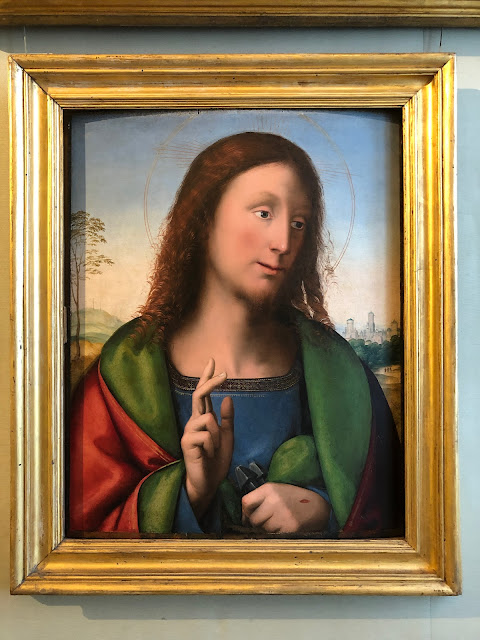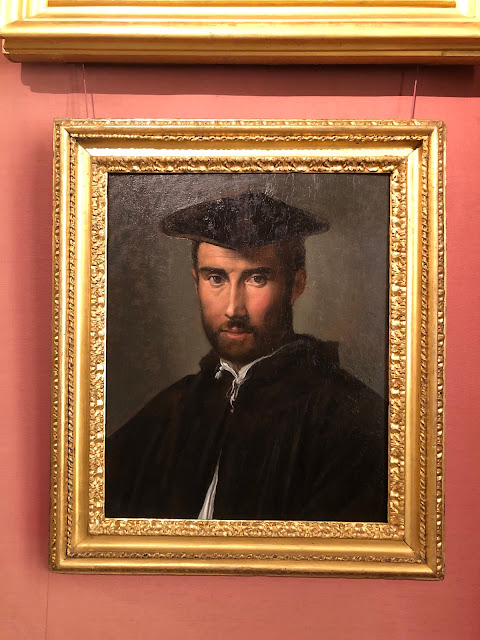【ローマ】ボルゲーゼ美術館 その他の作品 Roma - Museo e Galleria Borghese & Other works
ボルゲーゼ美術館には、ベルニーニやカラヴァッジオの他にも、叔父を教皇に持ち枢機卿として絶大な権力を握ったシピオーネ・ボルゲーゼが、その力と金を使った収集した多くの美術品が、元々は別荘だった部屋の中に展示されている。
ペルージャ近郊の村で生まれた、ペルジーノのキリスト像。
ここに描かれているキリストは、左の手には磔の跡が残されているが、アニメチックに描かれたその表情は実に優しげで、そうした苦労を微塵も感じさせない。
ペルジーノは優美でいかにも一般受けしそうな絵画を自らの工房で大量に制作した。この作品もそうした特徴がよく表れている。
In the Borghese Gallery, in addition to Bernini and Caravaggio, many works of art collected by Sipione Borghese, who had an uncle as a pope and had great power as a cardinal, were originally villas. It is exhibited in the room.
A statue of Christ the Redeemer in Perugino, born in a village near Perugia.
The Christ depicted here has a crucifixion mark on his left hand, but the animated expression is so gentle that he does not feel such a hardship.
Perugino produced a large number of graceful and popular paintings in his own workshop. This work also shows such characteristics well.
フラチェスコ・マッツォーラ、通称パルミジャーノの『男の肖像』。
パルミジャーノの作品は、フィレンツェのウフィツィ美術館で『長い首の聖母』などの宗教画の作品を見た。
そこではユニークな聖母のねじれた体の表現が印象的だったが、この肖像画はいたってオーソドックスな技法で描かれていて、その表現力の確かさがうかがえる。
パルミジャーノは、その名前の通りパルマで1503年に生まれ、その後ローマに出てメディチ家出身のクレメンス7世の庇護を受けて多くの作品を手がけた。
この作品が描かれたのは1526年だが、その翌年には神聖ローマ皇帝カール5世がローマに攻め込んだ”ローマ劫掠”があり、パルメジャーノはローマを離れた。
Frachesco Mazzola, commonly known as Parmesan's "Portrait of a Man".
For Parmesan's work, I saw works of religious paintings such as "Madonna with the Long Neck" at the Uffizi Gallery in Florence.
The unique expression of the twisted body of Our Lady was impressive, but this portrait is drawn with an orthodox technique, which shows the certainty of its expressiveness.
Parmesan, as the name implies, was born in Parma in 1503, then went to Rome and worked on many works under the patronage of Pope Clement VII from the Medici family.
This work was drawn in 1526, but the following year there was a "Sack of Rome" in which the Holy Roman Emperor Charles V invaded Rome, and Parmesan left Rome.
ドメニキーノの『狩の女神ディアーナ』。
ドメニキーノは1581年にボローニャに生まれた、バロック期の画家。同じボローニャ出身のカラッチ兄弟のアカデミアの一員になった。
この絵はなんといっても、左下でこちらを見つめる裸の少女の表情が印象的。絵のテーマは女神ディアナだが、明らかにこの少女がこの絵の主役だ。
シピオーネ・ボルゲーゼ枢機卿は、この絵を画家のアトリエで一目見て気に入ってしまい、他に注文主がいたにも関わらず、この絵を強引に手に入れてしまったという。シピオーネ・ボルゲーゼが当時持っていた権力の大きさがわかる。
ドメニキーノは、バロック期の画家としては珍しく風景を丁寧に描いた画家で、それがクロード・ロランに大きな影響を与えた。
そう言われてこの絵をもう一度よく見てみると、右上の遠景の表現などは、クロード・ロランの絵のように見えてくる。
Domenichino's "Goddess of Hunting Diana".
Domenichino was a Baroque painter born in Bologna in 1581. He became a member of the Karachi brothers' academia from the same Bologna.
After all, the expression of a naked girl staring at us in the lower left is impressive. The theme of the painting is Goddess Diana, but obviously this girl is the protagonist of this painting.
Cardinal Scipione Borghese liked the painting at first glance in the painter's studio, and he said he had forcibly obtained it, despite the fact that there were other orderers. You can see how much power Sipione Borghese had at that time.
Domenichino was a painter who carefully painted landscapes, which is rare for a Baroque painter, and it had a great influence on Claude Lorrain.
With that said, if you take a closer look at this painting, the expression of the distant view in the upper right will look like Claude Lorrain's painting.
ボルゲーゼ美術館には、ヴェネツィア派の画家たちの作品も展示されている。
ジョヴァンニ・ベッリーニの聖母子像。
カラヴァッジオの絵と比べると、その静謐な世界観が際立っている。
聖母マリアと幼子イエスは、聖人としての雰囲気と、市井の母親と赤ん坊のような庶民性の両方の特徴を持ち合わせている。
The Borghese Gallery also displays the works of Venetian painters.
Giovanni Bellini's Madonna and Child.
Compared to Caravaggio's paintings, its tranquil worldview stands out.
The Virgin Mary and the infant Jesus have both the characteristics of a saint and the commonality of Ichii's mother and baby.
ティツィアーノが1514年に描いた『聖なる愛と俗なる愛』。
ティツィアーノが20代の後半に描いた作品で、同時期にはウフィツィ美術館で目にした『フローラ』なども描いている。
左側の着衣の女性は聖なる愛を、右側の裸の女性は俗なる愛を象徴していると考えられているが、よくよくこの絵を見ていくと、様々なものが描かれていて、それぞれが意味を持っているようだ。
左の女性は大きな器から草花を取り出していて、右の女性は左上にお香の器のようなものを掲げている。真ん中のキューピッドは水の中に手を入れて、何かを掴もうとしている。
二人の女性の背後の景色に描かれている左右の風景も、それぞれに意味がありそうだ。
"Holy love and profane love" by Titian in 1514.
This work was drawn by Titian in his late twenties, including "Flora," which he saw at the Uffizi Gallery at the same time.
The woman in clothes on the left is thought to symbolize holy love, and the naked woman on the right is thought to symbolize profane love. Each seems to have a meaning.
The woman on the left is pulling flowers out of a large bowl, and the woman on the right is holding something like an incense bowl in her upper left. Cupid in the middle of her is trying to grab something by putting her hand in the water.
The left and right landscapes depicted in the landscape behind the two women also seem to have meaning in each.
ヴェロネーゼが1561年に描いた『バプテスマの聖ヨハネ』。
同じ頃にヴェロネーゼは、ナポレオンがパリに持ち帰ってしまい今はルーヴル美術館にある『カナの結婚』を描いている。
聖ヨハネが右手に示す方向には、遠くのキリストと思しき人物が描かれている。距離が遠いことを意識して薄い色合いが描かれているが、それがまるで未完成の絵画のように見える。
"St. John of Baptism" by Veronese in 1561.
Around the same time, Veronese portrays "The Marriage of Kana," which Napoleon brought back to Paris and is now in the Louvre.
In the direction St. John points to his right hand, a person who seems to be Christ in the distance is drawn. Light colors are drawn in consideration of the distance, but it looks like an unfinished painting.








コメント
コメントを投稿